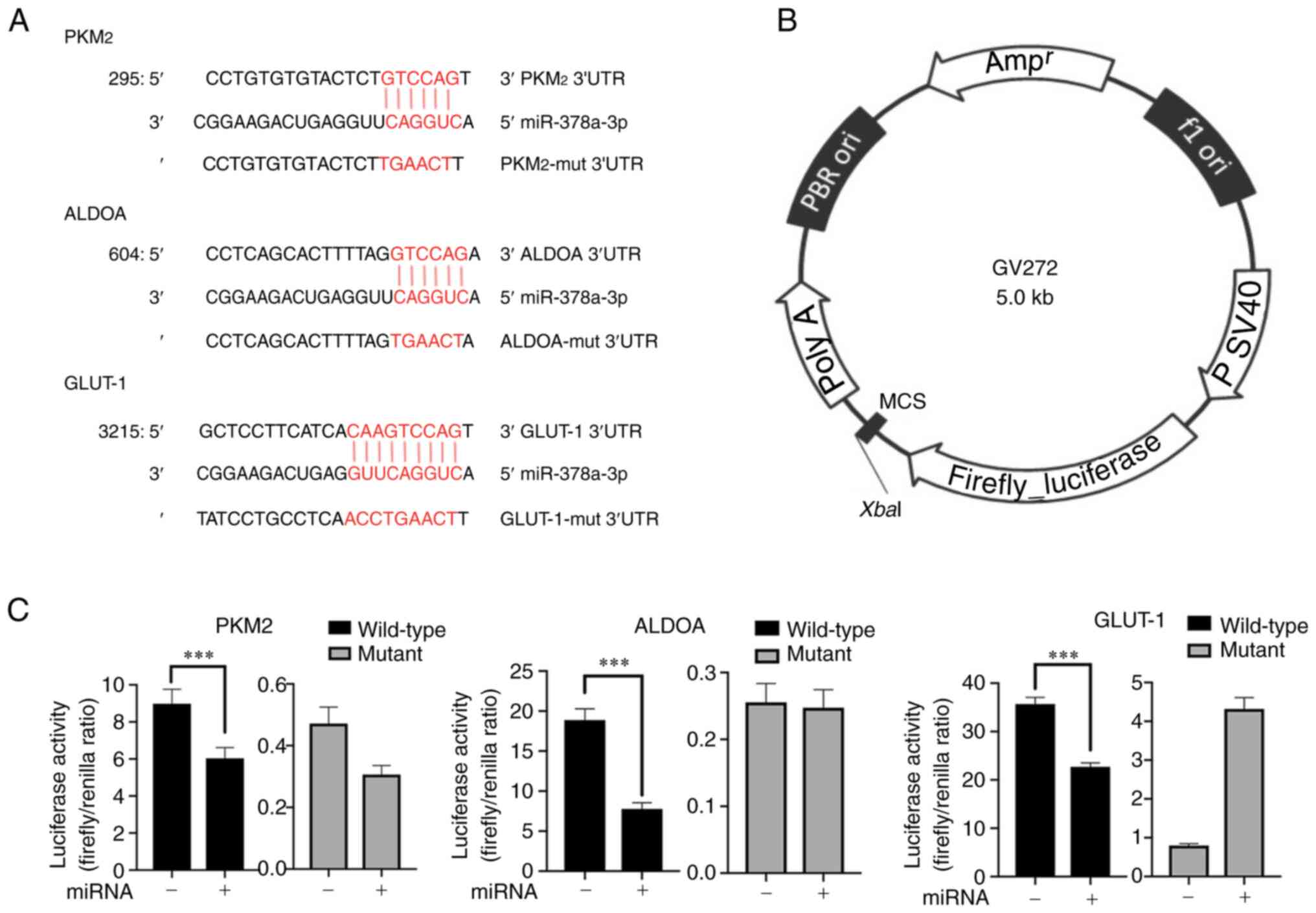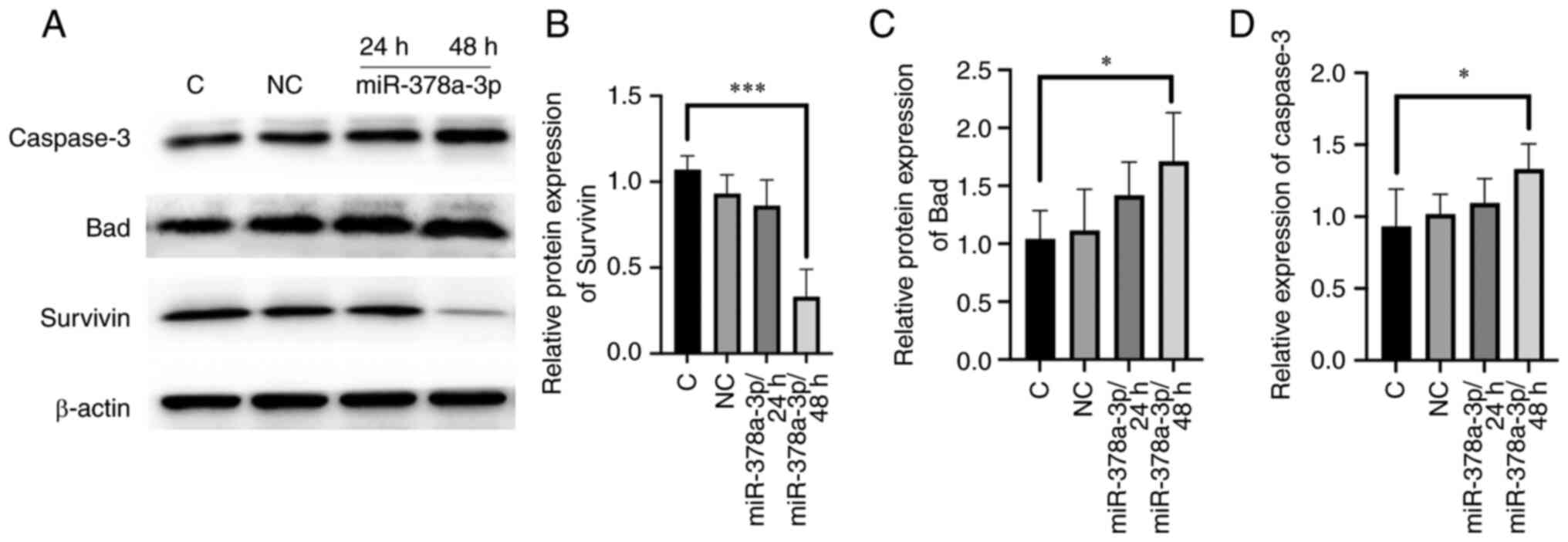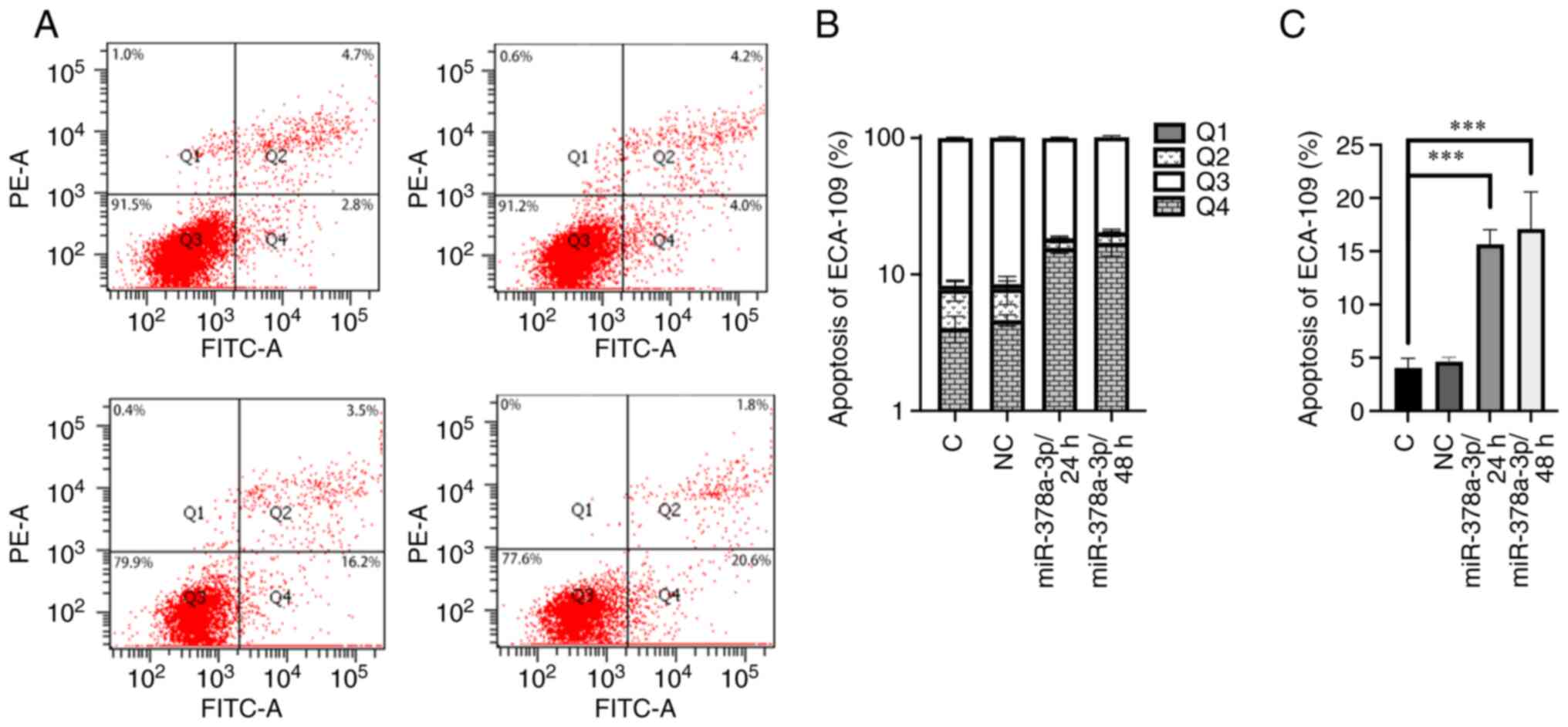|
1
|
Pennathur A, Gibson MK, Jobe BA and
Luketich JD: Oesophageal carcinoma. Lancet. 381:400–412. 2013.
View Article : Google Scholar : PubMed/NCBI
|
|
2
|
Zheng R, Zhang S, Zeng H, Wang S, Sun K,
Sun R, Li L, Wei W and Wei J: Cancer incidence and mortality in
China, 2016. J National Cancer Center. 2:1–9. 2022. View Article : Google Scholar
|
|
3
|
Kamangar F, Dores GM and Anderson WF:
Patterns of cancer incidence, mortality, and prevalence across five
continents: Defining priorities to reduce cancer disparities in
different geographic regions of the world. J Clin Oncol.
24:2137–2150. 2006. View Article : Google Scholar : PubMed/NCBI
|
|
4
|
Guo P, Huang ZL, Yu P and Li K: Trends in
cancer mortality in China: An update. Ann Oncol. 23:2755–2762.
2012. View Article : Google Scholar : PubMed/NCBI
|
|
5
|
Dubecz A, Gall I, Solymosi N, Schweigert
M, Peters JH, Feith M and Stein HJ: Temporal trends in long-term
survival and cure rates in esophageal cancer: A SEER database
analysis. J Thorac Oncol. 7:443–447. 2012. View Article : Google Scholar : PubMed/NCBI
|
|
6
|
Ohashi S, Miyamoto S, Kikuchi O, Goto T,
Amanuma Y and Muto M: Recent advances from basic and clinical
studies of esophageal squamous cell carcinoma. Gastroenterology.
149:1700–1715. 2015. View Article : Google Scholar : PubMed/NCBI
|
|
7
|
Ambros V: The functions of animal
microRNAs. Nature. 431:350–355. 2004. View Article : Google Scholar : PubMed/NCBI
|
|
8
|
Rottiers V and Naar AM: MicroRNAs in
metabolism and metabolic disorders. Nat Rev Mol Cell Biol.
13:239–250. 2012. View
Article : Google Scholar : PubMed/NCBI
|
|
9
|
Peng Y and Croce CM: The role of MicroRNAs
in human cancer. Signal Transduct Target Ther. 1:150042016.
View Article : Google Scholar : PubMed/NCBI
|
|
10
|
Su Z, Yang Z, Xu Y, Chen Y and Yu QJO:
MicroRNAs in apoptosis, autophagy and necroptosis. Oncotarget.
6:8474–8490. 2015. View Article : Google Scholar : PubMed/NCBI
|
|
11
|
Ivey KN and Srivastava D: MicroRNAs as
regulators of differentiation and cell fate decisions. Cell Stem
Cell. 7:36–41. 2010. View Article : Google Scholar : PubMed/NCBI
|
|
12
|
Machado IF, Teodoro JS, Palmeira CM and
Rolo AP: miR-378a: A new emerging microRNA in metabolism. Cell Mol
Life Sci. 77:1947–1958. 2020. View Article : Google Scholar : PubMed/NCBI
|
|
13
|
Liu B, Qu J, Xu F, Guo Y, Wang Y, Yu H and
Qian B: MiR-195 suppresses non-small cell lung cancer by targeting
CHEK1. Oncotarget. 6:9445–9456. 2015. View Article : Google Scholar : PubMed/NCBI
|
|
14
|
Valeri N, Braconi C, Gasparini P, Murgia
C, Lampis A, Paulus-Hock V, Hart JR, Ueno L, Grivennikov SI, Lovat
F, et al: MicroRNA-135b promotes cancer progression by acting as a
downstream effector of oncogenic pathways in colon cancer. Cancer
Cell. 25:469–483. 2014. View Article : Google Scholar : PubMed/NCBI
|
|
15
|
Pedroza-Torres A, Campos-Parra AD,
Millan-Catalan O, Loissell-Baltazar YA, Zamudio-Meza H, Cantú de
León D, Montalvo-Esquivel G, Isla-Ortiz D, Herrera LA,
Ángeles-Zaragoza Ó, et al: MicroRNA-125 modulates radioresistance
through targeting p21 in cervical cancer. Oncol Rep. 39:1532–1540.
2018.PubMed/NCBI
|
|
16
|
Pedroza-Torres A, Fernández-Retana J,
Peralta-Zaragoza O, Jacobo-Herrera N, Cantú de Leon D, Cerna-Cortés
JF, Lopez-Camarillo C and Pérez-Plasencia C: A microRNA expression
signature for clinical response in locally advanced cervical
cancer. Gynecol Oncol. 142:557–565. 2016. View Article : Google Scholar : PubMed/NCBI
|
|
17
|
Chen LT, Xu SD, Xu H, Zhang JF, Ning JF
and Wang SF: MicroRNA-378 is associated with non-small cell lung
cancer brain metastasis by promoting cell migration, invasion and
tumor angiogenesis. Med Oncol. 29:1673–1680. 2012. View Article : Google Scholar : PubMed/NCBI
|
|
18
|
Qin Y, Liang R, Lu P, Lai L and Zhu X:
Depicting the Implication of miR-378a in Cancers. Technol Cancer
Res Treat. 21:153303382211343852022. View Article : Google Scholar : PubMed/NCBI
|
|
19
|
Krist B, Florczyk U,
Pietraszek-Gremplewicz K, Józkowicz A and Dulak J: The role of
miR-378a in metabolism, angiogenesis, and muscle biology. Int J
Endocrinol. 2015:2817562015. View Article : Google Scholar : PubMed/NCBI
|
|
20
|
Wang Y and Du J: miR-378a-3p regulates
glioma cell chemosensitivity to cisplatin through IGF1R. Open Life
Sci. 16:1175–1181. 2021. View Article : Google Scholar : PubMed/NCBI
|
|
21
|
Ding N, Sun X, Wang T, Huang L, Wen J and
Zhou Y: miR-378a-3p exerts tumor suppressive function on the
tumorigenesis of esophageal squamous cell carcinoma by targeting
Rab10. Int J Mol Med. 42:381–391. 2018.PubMed/NCBI
|
|
22
|
Liu H, Zhang Q, Song Y, Hao Y, Cui Y,
Zhang X, Zhang X, Qin Y, Zhu G, Wang F, et al: Long non-coding RNA
SLC2A1-AS1 induced by GLI3 promotes aerobic glycolysis and
progression in esophageal squamous cell carcinoma by sponging
miR-378a-3p to enhance GLUT-1 expression. J Exp Clin Cancer Res.
40:2872021. View Article : Google Scholar : PubMed/NCBI
|
|
23
|
Hong L, Yu T, Xu H, Hou N, Cheng Q, Lai L,
Wang Q, Sheng J and Huang H: Down-regulation of miR-378a-3p induces
decidual cell apoptosis: A possible mechanism for early pregnancy
loss. Hum Reprod. 33:11–22. 2018. View Article : Google Scholar : PubMed/NCBI
|
|
24
|
Vander Heiden MG, Cantley LC and Thompson
CB: Understanding the Warburg effect: The metabolic requirements of
cell proliferation. Science. 324:1029–1033. 2009. View Article : Google Scholar : PubMed/NCBI
|
|
25
|
Hong X, Zhong L, Xie Y, Zheng K, Pang J,
Li Y, Yang Y, Xu X, Mi P, Cao H, et al: Matrine Reverses the
Warburg effect and suppresses colon cancer cell growth via
negatively regulating HIF-1α. Front Pharmacol. 10:14372019.
View Article : Google Scholar : PubMed/NCBI
|
|
26
|
Tirpe AA, Gulei D, Ciortea SM, Crivii C
and Berindan-Neagoe I: Hypoxia: Overview on Hypoxia-Mediated
mechanisms with a focus on the role of HIF genes. Int J Mol Sci.
20:61402019. View Article : Google Scholar : PubMed/NCBI
|
|
27
|
Comelli M, Di Pancrazio F and Mavelli I:
Apoptosis is induced by decline of mitochondrial ATP synthesis in
erythroleukemia cells. Free Radic Biol Med. 34:1190–1199. 2003.
View Article : Google Scholar : PubMed/NCBI
|
|
28
|
Marzieh A, Saeed T, Elina K, Omid V,
Mortaza TA, Mahshid T and Amir S: Caspase-3: Structure, function,
and biotechnological aspects. Biotechnol Appl Biochem.
69:1633–1645. 2022. View Article : Google Scholar : PubMed/NCBI
|
|
29
|
Altieri DC: Survivin-The inconvenient IAP.
Semin Cell Dev Biol. 39:91–96. 2015. View Article : Google Scholar : PubMed/NCBI
|
|
30
|
Budhidarmo R and Day CL: IAPs: Modular
regulators of cell signalling. Semin Cell Dev Biol. 39:80–90. 2015.
View Article : Google Scholar : PubMed/NCBI
|
|
31
|
Chu SF, Zhang Z, Zhang W, Zhang MJ, Gao Y,
Han N, Zuo W, Huang HY and Chen NH: Upregulating the expression of
Survivin-HBXIP complex contributes to the protective role of
IMM-H004 in transient global cerebral Ischemia/Reperfusion. Mol
Neurobiol. 54:524–540. 2017. View Article : Google Scholar : PubMed/NCBI
|
|
32
|
Dai L, Li JL, Liang XQ, Li L, Feng Y, Liu
HZ, Wei WE, Ning SF and Zhang LT: Flowers of Camellia nitidissima
cause growth inhibition, cell-cycle dysregulation and apoptosis in
a human esophageal squamous cell carcinoma cell line. Mol Med Rep.
14:1117–1122. 2016. View Article : Google Scholar : PubMed/NCBI
|
|
33
|
Zhang C, Ma Q, Shi Y, Li X, Wang M, Wang
J, Ge J, Chen Z, Wang Z and Jiang H: A novel
5-fluorouracil-resistant human esophageal squamous cell carcinoma
cell line Eca-109/5-FU with significant drug resistance-related
characteristics. Oncol Rep. 37:2942–2954. 2017. View Article : Google Scholar : PubMed/NCBI
|
|
34
|
Yao J, Shen X, Li H, Xu J, Shao S, Huang
JX and Lin M: LncRNA-ECM is overexpressed in esophageal squamous
cell carcinoma and promotes tumor metastasis. Oncol Lett.
16:3935–3942. 2018.PubMed/NCBI
|
|
35
|
Liu L, Han S, Xiao X, An X, Gladkich J,
Hinz U, Hillmer S, Hoppe-Tichy T, Xu Y, Schaefer M, et al:
Glucocorticoid-induced microRNA-378 signaling mediates the
progression of pancreatic cancer by enhancing autophagy. Cell Death
Dis. 13:10522022. View Article : Google Scholar : PubMed/NCBI
|
|
36
|
Xu ZH, Yao TZ and Liu W: miR-378a-3p
sensitizes ovarian cancer cells to cisplatin through targeting
MAPK1/GRB2. Biomed Pharmacother. 107:1410–1417. 2018. View Article : Google Scholar : PubMed/NCBI
|
|
37
|
Gao S, Yu Y, Liu L, Meng J and Li G:
Circular RNA hsa_circ_0007059 restrains proliferation and
epithelial-mesenchymal transition in lung cancer cells via
inhibiting microRNA-378. Life Scis. 233:1166922019. View Article : Google Scholar : PubMed/NCBI
|
|
38
|
Yang YJ, Luo S and Wang LS: Effects of
microRNA-378 on epithelial-mesenchymal transition, migration,
invasion and prognosis in gastric carcinoma by targeting BMP2. Eur
Rev Med Pharmacol Sci. 23:5176–5186. 2019.PubMed/NCBI
|
|
39
|
Cui Z, Sun S, Liu Q, Zhou X, Gao S, Peng P
and Li Q: MicroRNA-378-3p/5p suppresses the migration and
invasiveness of oral squamous carcinoma cells by inhibiting KLK4
expression. Biochem Cell Biol. 98:154–163. 2020. View Article : Google Scholar : PubMed/NCBI
|
|
40
|
Fu JH, Yang S, Nan CJ, Zhou CC, Lu DQ, Li
S and Mu HQ: MiR-182 affects renal cancer cell proliferation,
apoptosis, and invasion by regulating PI3K/AKT/mTOR signaling
pathway. Eur Rev Med Pharmacol Sci. 22:351–357. 2018.PubMed/NCBI
|
|
41
|
Ou DL, Lee BS, Lin LI, Liou JY, Liao SC,
Hsu C and Cheng AL: Vertical blockade of the IGFR-PI3K/Akt/mTOR
pathway for the treatment of hepatocellular carcinoma: The role of
survivin. Mol Cancer. 13:22014. View Article : Google Scholar : PubMed/NCBI
|
|
42
|
Meng Y, Lin ZM, Ge N, Zhang DL, Huang J
and Kong F: Ursolic acid induces apoptosis of prostate cancer cells
via the PI3K/Akt/mTOR pathway. Am J Chin Med. 43:1471–1486. 2015.
View Article : Google Scholar : PubMed/NCBI
|
|
43
|
Khwairakpam AD, Monisha J, Roy NK,
Bordoloi D, Padmavathi G, Banik K, Khatoon E and Kunnumakkara AB:
Vietnamese coriander inhibits cell proliferation, survival and
migration via suppression of Akt/mTOR pathway in oral squamous cell
carcinoma. J Basic Clin Physiol Pharmacol. 312019.doi:
10.1515/jbcpp-2019-0162. PubMed/NCBI
|
|
44
|
Guo RH, Wang TS, Shen H, Ge HM, Sun J,
Huang ZH and Shu YQ: Involvement of mTOR and survivin inhibition in
tamoxifen-induced apoptosis in human hepatoblastoma cell line
HepG2. Biomed Pharmacother. 64:249–253. 2010. View Article : Google Scholar : PubMed/NCBI
|
|
45
|
Li W, Du D and Li Y: Id-1 promotes
reendothelialization in the early phase after vascular injury
through activation of NFkB/survivin signaling pathway. Drug Des
Devel Ther. 13:3799–3811. 2019. View Article : Google Scholar : PubMed/NCBI
|
|
46
|
Fukayama M, Hino R and Uozaki H:
Epstein-Barr virus and gastric carcinoma: Virus-host interactions
leading to carcinoma. Cancer Sci. 99:1726–1733. 2008. View Article : Google Scholar : PubMed/NCBI
|
|
47
|
Jeyasuria P, Subedi K, Suresh A and Condon
JC: Elevated levels of uterine anti-apoptotic signaling may
activate NFKB and potentially confer resistance to caspase
3-mediated apoptotic cell death during pregnancy in mice. Biol
Reprod. 85:417–424. 2011. View Article : Google Scholar : PubMed/NCBI
|
|
48
|
Zeng W, Li H, Chen Y, Lv H, Liu L, Ran J,
Sun X, Bieerkehazhi S, Liu Y, Li X, et al: Survivin activates NF-κB
p65 via the IKKβ promoter in esophageal squamous cell carcinoma.
Mol Med Rep. 13:1869–1880. 2016. View Article : Google Scholar : PubMed/NCBI
|
|
49
|
Eichner LJ, Perry MC, Dufour CR, Bertos N,
Park M, St-Pierre J and Giguère V: miR-378(*) mediates metabolic
shift in breast cancer cells via the PGC-1β/ERRγ transcriptional
pathway. Cell Metab. 12:352–361. 2010. View Article : Google Scholar : PubMed/NCBI
|
|
50
|
Wang Y, Zhang X, Wang Z, Hu Q, Wu J, Li Y,
Ren X, Wu T, Tao X, Chen X, et al: LncRNA-p23154 promotes the
invasion-metastasis potential of oral squamous cell carcinoma by
regulating GLUT-1-mediated glycolysis. Cancer Lett. 434:172–183.
2018. View Article : Google Scholar : PubMed/NCBI
|
|
51
|
Chen Y, Sun R, Han W, Zhang Y, Song Q, Di
C and Ma D: Nuclear translocation of PDCD5 (TFAR19): An early
signal for apoptosis? FEBS Lett. 509:191–196. 2011. View Article : Google Scholar : PubMed/NCBI
|
















